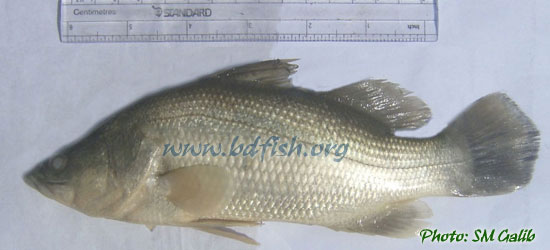
Systematic position:
Phylum: Chordata
Class: Actinopterygii (Ray-finned fishes)
Order: Perciformes (Perchs)
Family: Centropomidae (Giant perch and glass fishes)
Genus: Lates
Species: L. calcarifer
Synonyms
Coius vacti Hamilton, 1822
Holocentrus calcarifer Bloch, 1790
Lates darwiniensis Macleay, 1878
Pseudolates cavifrons Alleyne & Macleay, 1877
Common names: Vetki (ভেটকী) and coral (কোরাল) (Bangladesh); Barramundi, white seabass, silver seaperch, gient perch, palmer, cock-up seabass (English).
Distribution: Bangladesh, India, Pakistan, Myanmar and Thailand (Yadav, 1999); also southward to Queensland (Australia) and westward to East Africa (Kungvankij et al., 1986).
Conservation status: Non-threatened in Bangladesh.
Morphology: Elongated and compressed body with pointed head. Mouth large, protractile with longer lower jaw than upper. Greenish above and silvery below. Pectoral short and rounded. Anal and caudal also rounded.
Fin formula: D. VII+I/11-12; P1. 16-17; P2; I/6; A. III/8-9 (Rahman, 1989)
Maximum length: Maximum length reported 200 cm (Huda et al., 2003) and 31 cm (Rahman, 1989).
Habitat: Bay of Bengal, estuaries and tidal rivers, sometimes in freshwater; commonly found in estuaries of Barishal, Patuakhali and Khulna (Rahman, 1989). Eurihaline and catadromous species (Kungvankij et al., 1986).
Food and feeding: Adults are voracious carnivore. Juvenile are omnivore (Kungvankij et al., 1986).
Breeding: It grows in freshwater and migrates to more saline water for breeding (Kungvankij et al., 1986). Mature fish are found in the river mouths, lakes or lagoons of 30-32 ppm water salinity and 10-15 meter water depth (Kungvankij et al., 1986). Fecundity related to size and weight; 2.1 to 7.1 million (5.5 kg to 11 kg), 7.5 million (12 kg), 8.5 million (19 kg) and 17 million (22 kg) (Wongsomnuk and Maneewongsa, 1974; Anonymous, 1980).
Economics importance: Used as food fish in Bangladesh. Also serve as game fish (Yadav, 1999).
________________________________________________________________
References
Anonymous. 1980. Working paper on seabass production and culture workshop, Brackishwater Fisheries Division, Department of Fisheries, 4: 60-78. in Kungvankij P, Pudadera BJ, Tiro JR LB and Potestas IO. 1986. Biology and culture of sea bass (Lates calcarifer), NACA training manual series No. 3, Bangkok, Thailand, 70 pp.
Huda MS, Haque ME, Babul AS and Shil NC (ed.). 2003. Field guide to finfishes of Sundarban, Aquatic resources division, Sundarban, Boyra, Khulna, Bangladesh, p. 104.
Kungvankij P, Pudadera BJ, Tiro JR LB and Potestas IO. 1986. Biology and culture of sea bass (Lates calcarifer), NACA training manual series No. 3, Bangkok, Thailand, 70 pp.
Rahman AKA. 1989. Freshwater Fishes of Bangladesh, 1st edition, Zoological Society of Bangladesh, Department of Zoology, University of Dhaka, Dhaka-1000, pp. 337-338.
Wongsomnuk S and Maneewongsa S. 1974. Biology and artificial propagation of seabass Lates calcarifer Bloch, Report on the first Mangrove Ecology Workshop, 2(3): 645-664.
Yadav BN. 1999. Fish and Fisheries, Daya Publishing House, Delhi, India, p. 323.
Visited 5,360 times, 1 visits today | Have any fisheries relevant question?
